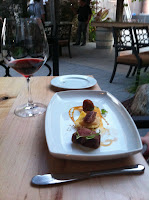 Last weekend, Chris, Kerri and I headed to Hinterbrook Winery in Niagara-on-the-Lake. Now, if you read my blog regularly, you may have noticed that everyone in my life is named Kerri. To clarify, this was not Carrie from work who has appeared on Newlywined a few times, nor was it Chris' sister Kerri, who is way too pregnant to be doing wine tours just now. This is childhood-best-friend turned maid-of-honour Kerri who lives in BC but was home for a visit.
Last weekend, Chris, Kerri and I headed to Hinterbrook Winery in Niagara-on-the-Lake. Now, if you read my blog regularly, you may have noticed that everyone in my life is named Kerri. To clarify, this was not Carrie from work who has appeared on Newlywined a few times, nor was it Chris' sister Kerri, who is way too pregnant to be doing wine tours just now. This is childhood-best-friend turned maid-of-honour Kerri who lives in BC but was home for a visit. Anyhow, a few months ago, the Wagjag deal of the day was a $25 passport of tastings at five wineries for two people. Of the five wineries, Hinterbrook is the only one I haven't reviewed here before. It's quite close to Palantine Hills, and, like its neighbour, also houses some 1812 war relics, so I imagine the vineyards in that neighbourhood were once strategically important, despite being closer to the lake than to the river. The winery property is interesting, as you drive through the vineyard and around the estate's residence, both quite elegant and stately, before arriving at the wine store, essentially a big shed. Our host for the visit, Rick, was very passionate and knowledgeable about Hinterbrook's products, reminding me of Maleta. Like Maleta, Hinterbrook also focuses on a limited number of quality wines that aren't available in the LCBO.
Anyhow, a few months ago, the Wagjag deal of the day was a $25 passport of tastings at five wineries for two people. Of the five wineries, Hinterbrook is the only one I haven't reviewed here before. It's quite close to Palantine Hills, and, like its neighbour, also houses some 1812 war relics, so I imagine the vineyards in that neighbourhood were once strategically important, despite being closer to the lake than to the river. The winery property is interesting, as you drive through the vineyard and around the estate's residence, both quite elegant and stately, before arriving at the wine store, essentially a big shed. Our host for the visit, Rick, was very passionate and knowledgeable about Hinterbrook's products, reminding me of Maleta. Like Maleta, Hinterbrook also focuses on a limited number of quality wines that aren't available in the LCBO.
The first wine we tasted was the 2011 Pinot Grigio, not a wine I would usually drink and not a cool climate grape partial to Ontario. It features a surprising aroma and taste of banana, reminding me of the regular harvest vidal we'd tried last winter at Magnotta, only not so sickly sweet or candy like. (The winery's tasting notes do mention candy floss though!) It definitely makes for easy drinking, so for the $14 price tag we bought a bottle that will ultimately become boat wine.
The next wine we tasted was the 2011 Franc Blanc, Hinterbrook's specialty that no one else bottles. (I meant to ask, but I assume the process is patented because it doesn't sound difficult and the result is yummy.) They start with cab franc (red) grapes but remove the skins immediately after pressing, before fermentation. The result is a peachy-coloured wine that smells and tastes like a white but feels like a red. A big part of its appeal is that it plays with your expectations. For example, you wouldn't anticipate this big of a mouthfeel, a slightly chewy texture, the medium-long finish, or such substantial legs on a wine this colour. Similarly, I found the scent and taste both hard to describe because I had nothing to go on, but since we bought two bottles, I've since had a couple of glasses at home "to clarify". The nose is not particularly big and changes dramatically as the wine warms up out of the fridge. A vigorous swirl will reveal a chalky or musky smell reminiscent of lavender and dew. As it gets warmer, but still well below room temperature, candy floss is also detectable. The various citrus flavours, plus a banana undertone, marry well and are hard to identify separately, sort of like Five Alive. (I do find it odd that banana and candy floss ended up in two of their wines made from very different grapes; what's going on in their soil?) Overall, I'm impressed with the complexity of this wine for what is basically a novelty wine. It's like boat wine, but more sophisticated.
Before leaving, we also tasted Hinterbrook's Deeply Red and its Merlot, but I'll save those reviews for another day.















